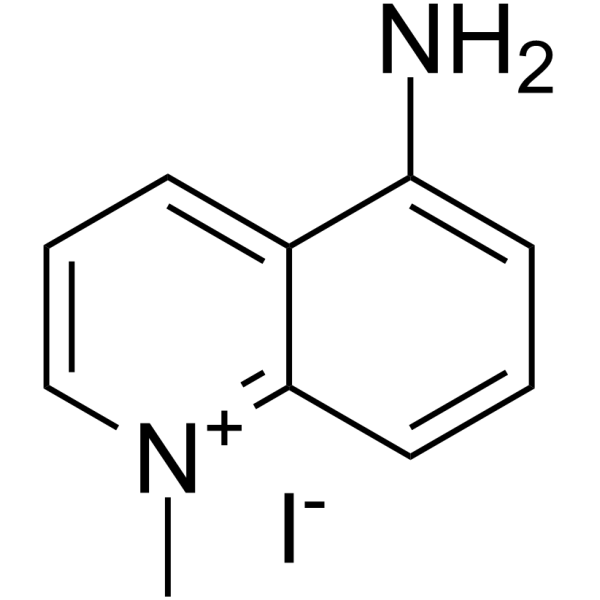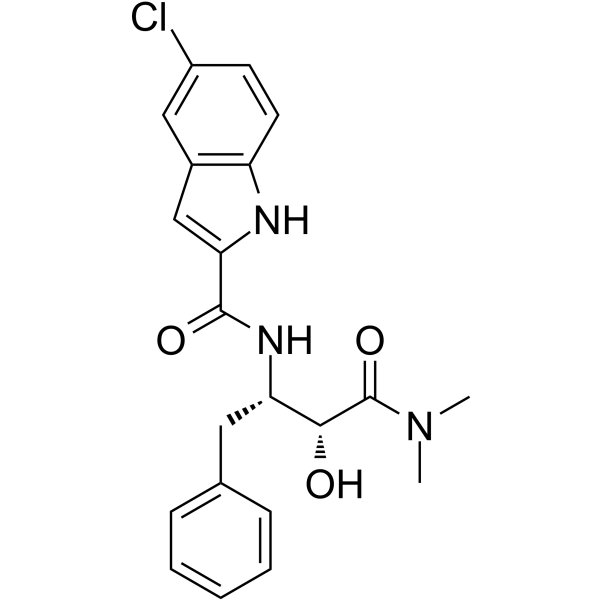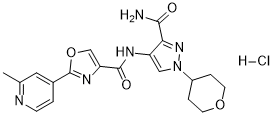 To enhance service speed and avoid tariff delays, we've opened a US warehouse. All US orders ship directly from our US facility.
To enhance service speed and avoid tariff delays, we've opened a US warehouse. All US orders ship directly from our US facility.
| Cat. No. | Product Name | Field of Application | Chemical Structure |
|---|---|---|---|
| DC11448 | LOXO 195(Selitrectinib) Featured |
LOXO-195 is a next-generation TRK kinase (TKI) inhibitor, with IC50s of 0.6±0.1 nM, <2.5 nM for TRKA and TRKC respectively.
More description
|

|
| DC10867 | LP-211 Featured |
LP-211 is a selective and blood−brain barrier penetrant 5-HT7 receptor agonist, with a Ki of 0.58 nM, with high selectivity over 5-HT1A receptor (Ki, 188 nM) and D2 receptor (Ki, 142 nM).
More description
|

|
| DC22800 | ML-210 Featured |
A small-molecule probe that selectively kills cells induced to express mutant RAS.
More description
|

|
| DC22834 | Roseoflavin Featured |
Roseoflavin is a chemical analog of FMN and riboflavin that has antimicrobial activity.
More description
|

|
| DC22913 | WEB-2086 Featured |
A potent and specific antagonist of platelet activating factor (PAF) receptor that inhibits PAF-induced human platelet and neutrophil aggregation in vitro with IC50 of 0.17 and 0.36 uM, respectively.
More description
|

|
| DC11481 | AZD-0364 Featured |
AZD-0364 is a potent and selective ERK2 inhibitor extracted from patent WO2017080979A1, compound example 18, has an IC50 of 0.6 nM.
More description
|

|
| DC22989 | BMS-204493 Featured |
A pan-RAR inverse agonist that blocks RARα activity with IC50 of 114 nM.
More description
|

|
| DC36924 | NNMTi Featured |
NNMTi is a nicotinamide N-methyltransferase (NNMT) inhibitor that promotes myoblast differentiation.
More description
|

|
| DC23191 | ZL-006 Featured |
ZL-006 (ZL 006, ZL006) is a brain penetrant small molecule inhibitor of PSD-95/nNOS interaction that prevents glutamate-induced excitotoxicity and cerebral ischemic damage in vivo.
More description
|

|
| DC23195 | CBR-5884 Featured |
A potent, selective, noncompetitive inhibitor of 3-phosphoglycerate dehydrogenase (PHGDH) with IC50 of 7 uM.
More description
|

|
| DC23211 | SKF 82958 Featured |
A potent, full dopamine D1 agonist.
More description
|

|
| DC23227 | N6-Cyclohexyladenosine Featured |
An adenosine A1 receptor agonist (EC50= 8.2 nM)..
More description
|

|
| DC23228 | (R)-Baclofen hydrochloride Featured |
A derivative of the neurotransmitter GABA that acts as a GABAB receptor agonist.
More description
|

|
| DC23237 | Zaprinast Featured |
Zaprinast (M&B 22948) is a potent, cGMP-specific phosphodiesterase inhibitor with IC50 of 0.5-0.76 and 0.15 uM for PDE5 and PDE6 respectively, also is an agonist for GPR35 (EC50=16/840 nM for rat/human GPR35).
More description
|

|
| DC23372 | Olinone Featured |
Olinone is a selective inhibitor for the BET BRD1 with Kd of 3.4/3.7/8.6 uM for BRD4-BrD1/BRD3-BrD1/BRD2-BrD1, respectively, shows high selectivity over BET BRD2 (Kd>300 uM).
More description
|

|
| DC40765 | CP-91149 Featured |
CP-91149 is a GP (glycogen phosphorylase) inhibitor. CP-91149 promotes glycogen resynthesis, but not its overaccumulation. CP-91149 has the potential for Type II (insulin-dependent) diabetes study.
More description
|

|
| DC23552 | AS-2444697 HCl Featured |
A potent, selective, orally bioavailable IRAK-4 inhibitor that potently inhibits human and rat IRAK-4 activity with subnanomolar order, >30-fold selectivity over IRAK-1.
More description
|

|
| DC23589 | CGP 37157 Featured |
A specific inhibitor of mitochondrial Na(+)-Ca(2+) exchanger (mNCE) with IC50 of 1.5 uM in INS-1 cells.
More description
|

|
| DC23600 | PF-04856264 Featured |
PF-04856264 is a potent, selective Nav1.7 blocker with IC50 of 28 nM, dispalys >1,000-fold selectivity over Nav1.5.
More description
|

|
| DC23603 | Traxoprodil mesylate Featured |
A potent, selective N-methyl-D-aspartate (NMDA) antagonist with selectivity for the NR2B subunit.
More description
|

|
| DC23604 | ALX-5407 hydrochloride Featured |
ALX-5407 is a potent, selective, orally active inhibitor of GlyT1 glycine transporter with IC50 of 3 nM.
More description
|

|
| DC23623 | PF-06761281 Featured |
A potent, selective sodium-coupled citrate transporter (NaCT or SLC13A5) with IC50 of 0.51 uM, >20-fold selectivity over NaDC1 and NaDC3.
More description
|

|
| DC23626 | SCH-28080 Featured |
SCH-28080 is a potent, orally active, reversible inhibitor of gastric H+,K+-ATPase with IC50 of 20 nM.
More description
|

|
| DC8287 | Lubiprostone Featured |
Lubiprostone(SPI-0211;RU0211) is a gastrointestinal agent used for the treatment of idiopathic chronic constipation.
More description
|

|
| DC8611 | Luliconazole Featured |
Luliconazole(NND 502) is an azole antifungal indicated for the topical treatment of interdigital tinea pedis.
More description
|

|
| DC3173 | Lurasidone HCl Featured |
Lurasidone is an atypical antipsychotic, inhibits Dopamine D2, 5-HT2A, 5-HT7, 5-HT1A and noradrenaline α2C with IC50 of 1.68 nM, 2.03 nM, 0.495 nM, 6.75 nM and 10.8 nM, respectively.
More description
|

|
| DC9938 | Lusutrombopag(S-888711) Featured |
Lusutrombopag(S-888711) is an orally bioavailable, small molecule thrombopoietin (TPO) receptor agonist being developed by Shionogi for chronic liver disease (CLD) patients with thrombocytopenia prior to elective invasive surgery.
More description
|

|
| DC20271 | LUT014 Featured |
LUT014 is a novel BRAF agonist.
More description
|

|
| DC2072 | LXR623 Featured |
LXR-623 is a novel Liver X Receptor modulator
More description
|

|
| DC26012 | LXS-196 Featured |
LXS196 is a potent, selective and orally active protein kinase C (PKC) inhibitor, with IC50 values of 1.9 nM, 0.4 nM and 3.1 μM for PKCα, PKCθ and GSK3β, respectively. It can be used for the treatment of uveal melanoma.
More description
|

|